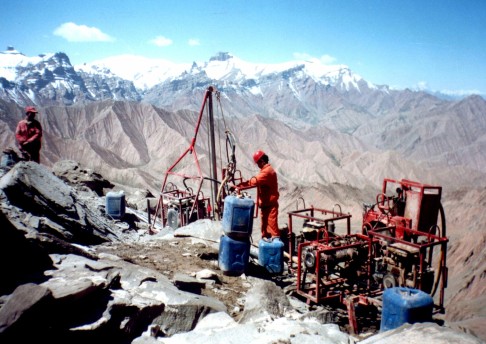The South China Morning Post Stephen Chen 30 July 2015
Chinese scientists say a huge ocean underneath Xinjiang's Tarim basin acts as a major carbon sink, protecting us from even greater global warming. Photo: Nasa
There could be an “ocean” hidden under one of the driest areas on earth, according to a breakthrough discovery by Chinese scientists.
The amount of salt water beneath the Tarim basin in northwestern Xinjiang province could be equivalent to 10 times the water in all five Great Lakes in North America.
“This is a terrifying amount of water,” said professor Li Yan, who led the study at the Chinese Academy of Sciences’ Xinjiang Institute of Ecology and Geography in Urumqi, the Xinjiang capital.
“Never before have people dared to imagine so much water under the sand. Our definition of desert may have to change,” he said.
The Tarim is the world’s largest landlocked basin and home to Taklimakan, the biggest desert in China. The basin is known for its rich oil reserves, but to access them requires large amounts of water.
For a long time scientists had suspected that melt water from high mountains nearby had sipped beneath the basin, but the exact amount of water reserves there remained unknown.
Precise estimates are difficult because surface water in the region, such as seasonal rivers and lakes appear at random times in inconsistent locations, making direct measurement impossible.
Li’s team stumbled on the discovery by accident.
“We were after carbon, not water,” he said.
Greenhouse gas carbon dioxide can be absorbed in certain regions known as "carbon sinks", such as forests and oceans. Locating these sinks may help scientists better understand climate change.
Around 10 years ago, Li’s team discovered large amounts of carbon dioxide disappearing in Tarim, with no explanation over where it could be going.
In a paper in the journal Geophysical Research Letters, Li’s team reported that there could be a large amount of water under earth's largest deserts which serve as carbon sinks as important as forests and oceans.
Under the Tarim desert, over a depth stretching thousands of metres, exists an enormous amount of saline water fll of carbon dioxide, they found.
The team obtained deep underground water samples from nearly 200 locations across the desert. By measuring the amount of carbon dioxide in these samples, and comparing them to the carbon dioxide in melt water, the scientists were able to calculate how much water had flown into the basin.
“Our estimate is a conservative figure. The actual amount could be larger,” Li said.
Melt water has been used by people in Xinjiang for agricultural irrigation for thousands of years.
The soil of farmland in the region is alkaline, helping the dissolving of carbon dioxide into the water. By dating the age of the carbon Li's team "recorded a jump of 'carbon sinking' after the opening of the ancient Silk Road more than two thousand years ago."
“CCS [carbon capture and storage] is a 21st century idea, but our ancestors may have been doing it unconsciously for thousands of years," he said.
However, Li emphasised that the "ocean" under Tarim would not be much immediate use for Xinjiang's economic development.
The water is not just salty, but contains a large amount of carbon dioxide. “It’s like a can of coke. If it is opened all the greenhouse gas will escape into the atmosphere,” he said.
The biggest question now is whether similar “oceans” can be also be found under other large deserts, such as Sahara. Li said they would work with research teams around the world to find out the answer.
The chance of water under these deserts is high because the amount of carbon these “oceans” carried could reach a trillion tonnes, which matches the amount of “missing carbon” on the planet, according to Li's team's calculations.


No comments:
Post a Comment